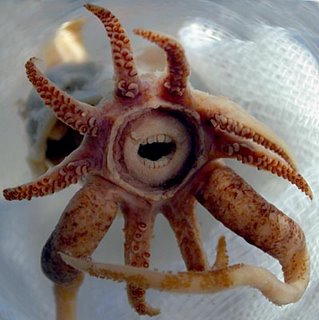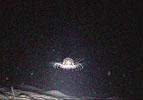MOST ABUNDANT
THE sighting of eight million fish swarming in a school the size of Manhattan qualified as the most abundant find in the census.
Fish counters making observations off the New Jersey coast used focused sound scans to examine oceanic areas 10,000 times larger than had been previously possible. The scan updates instantaneously, revealing the movements of the island-sized swarms....
FARTHEST
TRACKING tagged sooty shearwaters by satellite, census researchers mapped the small birds' 40,000-mile journey searching for food in a giant figure of eight over the Pacific Ocean, from New Zealand via Polynesia to Japan, Alaska and California and back.
Making the longest migration ever recorded electronically in only 200 days, the charcoal grey birds averaged a surprising 350km daily.
In some cases, a breeding pair made the entire journey together....
HOTTEST
THE hottest thermal vent was discovered 3km below the surface of the Atlantic Ocean. It is belching out fluids at an unprecedented 407C - a temperature which can easily melt lead.
Scientists want to study the deep-sea eco-system of plants and animals living in a "halo" around the vent, to discover how, surrounded by near-freezing water, their chemistry allows them to withstand heat pulses that approach boiling point - up to 80C.
Shrimps, mussels and clams were seen on the walls of the vent chimney....
NEW SPECIES
"SLOAN the squid", a new species capable of chewing its own food, was found by deep-sea investigators in the Mid-Atlantic Ridge.

Sloan (Promachoteuthis sloani) was among 80,000 organisms - covering 354 families, genera and species - found. It has become the reference specimen for the new species....
RICHEST
THE richest find in terms of biodiversity was 20,000 forms of bacteria in a single litre of sea water.
Microbe hunters took samples from the Atlantic and Pacific, including from an eruptive fissure 1,500 metres deep on a seamount in the Pacific.
DNA studies showed most of the different kinds of bacteria were unknown and likely to be rare globally....
DEEPEST
THE deepest sampling in the census took place 5km below the surface of the Sargasso Sea in the North Atlantic.
Experts from 14 nations caught rare, but diverse, zooplankton living in the ocean's deepest depths, in a sophisticated net called the Mocness....
DARKEST
CENSUS-takers in the Southern Ocean discovered a unique and astonishing community of marine life shrouded beneath 700m of ice, about 200km from open water.
During three lengthy cruises, sampling yielded more new than familiar species.

Among the scores of species found was a rare jellyfish, possibly cosmetirella davisi, which was filmed swimming with its tentacles raised....
OLDEST
THE oldest creature found by census seamount researchers was a shrimp believed to have become extinct around 50 million years ago.
The female creature was found alive and well 400 metres under the sea on an underwater peak during an expedition to the Chesterfield Islands, north-west of New Caledonia.
Neoglyphea neocaledonica was nicknamed "Jurassic shrimp" by its discoverers. It is about 5in long and has been described as "halfway between a shrimp and a mud lobster"....
No comments:
Post a Comment